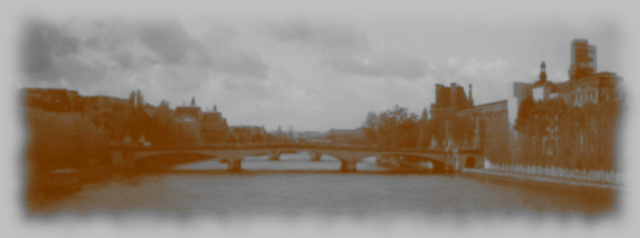Jumper

After Javert helps Valjean take Marius home, Javert allows him to walk inside for a moment, then leaves before Valjean walks back out.
Javert in Disarray has also been translated as “Javert Derailed” and “Javert off the Track.” The idea that there might be more than one path, or that kindness exists (and might be shown by a felon!) is utterly foreign to him – as is reflection, which he finds “singularly painful.” It’s not just that Valjean showed him kindness. That might have shaken him, but not killed him. But that he himself did as well? Inconceivable.
He doesn’t even think about “the young rebel,” figuring he was probably dead anyway – and apparently doesn’t recognize Marius as “that little nincompoop of a lawyer” from last winter.
The spot he’s gone to is known as a treacherous part of the river. Even strong swimmers falling from a boat don’t emerge.
His thoughts go back to M. Madeleine and the Champmathieu affair, when he found himself in dispute with his superior and the only proper course was to resign. Now he sees a higher authority, “But how resign from God?”
Once he makes his decision, he walks to the nearest police post, writes up a list of policy recommendations for the service, leaves it with the on-duty officer, then walks back to the bridge.
The list is an odd mix of practical matters like ensuring that police carrying out surveillance have backup, and specific prison practices that he can’t justify morally, like forcing prisoners to take off their shoes when returning from interrogation (which leads to hospital expenses). Some of them I can absolutely see as being thoughts Javert has had in his mind for a while, but never felt he had the standing to recommend them. Others he must have noticed, but wouldn’t have considered them wrong until today.
I’ve gone over it a few times and I’m still not sure how much is “This is my last chance to make these suggestions” and how much is “I can finally make recommendations without endangering my career.” Hugo details his thoughts on the dilemma in great detail, but the moment he decides, the POV steps out of his head.
It was the sepulchral moment that succeeds midnight, with the stars hidden by cloud and not a light to be seen in the houses of the Cité, not a passer-by, only the faint, distant gleam of a street-lamp and the shadowy outlines of Notre-Dame and the Palais de Justice.
The Hat
Moments before he jumps – well, drops forward is more accurate – he sets his hat down on the railing. Something about this jogged a faint memory of a school assignment to rewrite a scene. I vaguely recalled trying to write a version where he simply walked away, leaving his hat behind but otherwise keeping the events intact (Hugo doesn’t actually tell you he jumps at this point, only that there was a splash)…but I can’t imagine how I would have earned that.
I did find an assignment from high school theater class back in 1993, saved in a file format for a word processing program that no longer exists, but that fortunately used plain text with control codes so that it’s still readable. I wrote a shorter version of the scene, describing Javert’s thoughts and pulling something else out of it: The thought that if Valjean could change and become good, Javert could change and become evil. He was irreversibly contaminated, and had to remove himself from the world for its own good. I mentioned this to Katie, and she thought it sounded like something that Javert would consider…but his mind wouldn’t allow him to consciously think about it.
Pages covered: 1104-1109. Image: Photo of a bridge over the Seine, taken on a trip I took back in 1999 and run through a vintage filter (and there’s an odd coincidence about that shot). Next up: A happy ending? Don’t count on it!